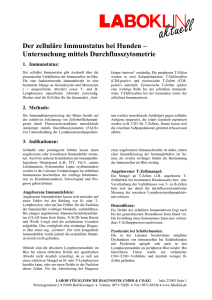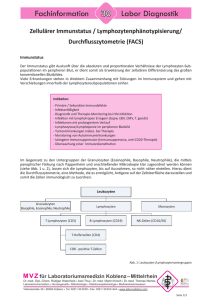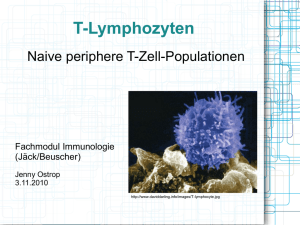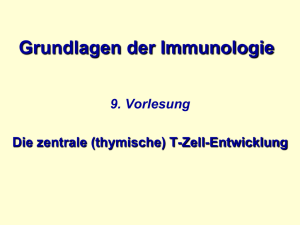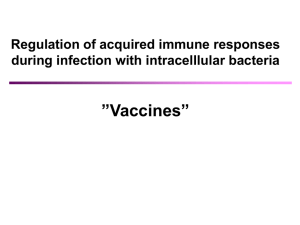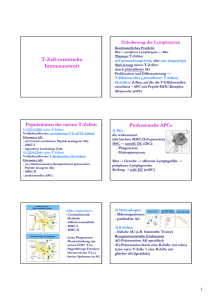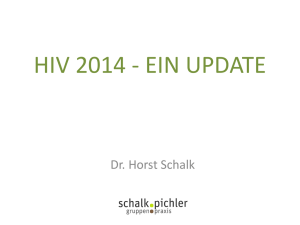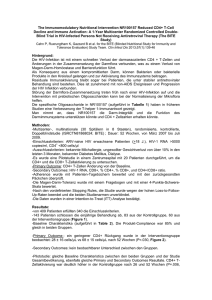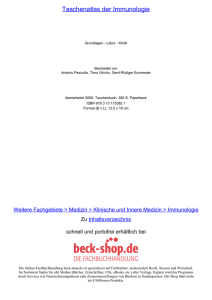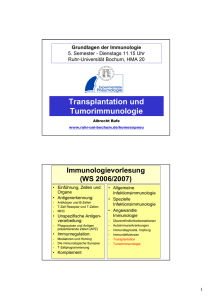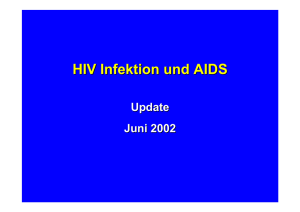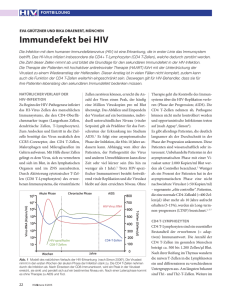T-Zellen als Effektor Zellen von Allergien
Werbung
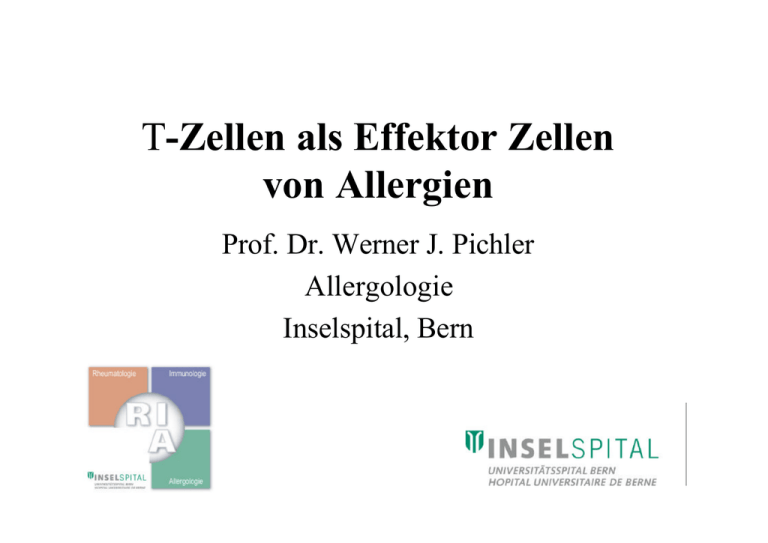
T-Zellen als Effektor Zellen von Allergien Prof. Dr. Werner J. Pichler Allergologie Inselspital, Bern „Virozyten“ (= aktivierte CD8+ T-Zellen) bei systemischer Immunaktivierung (z.B. generalisierte Medikamentenallergie, akutem EBV und HIV-Infekt,...) Normale, ruhende Lymphozyten Einteilung der T-Zellen • • • • TCR Erkennung/Restriktion Funktion naive/memory • Besonderheiten: – Affinität – T-Zell Aktivierung – altered peptide ligands Für quasi jedes Antigen gibt es TCR; Jeder TCR reagiert auch mit verschiedenen Ag; TCR-Peptide/MHC Kontaktzeit entscheidend für T-Zell Reaktivität TCR 1) αβ−TCR CD4+ CD8+ 2) γδ – TCR 3) CD4-/CD8- TCRα24/β11 (NK-T) CD4 - CD8 Dichotomie Keine funktionelle Unterscheidung (CD4 ≠ helfer T Zelle !), sondern Unterscheidung der Erkennung (Peptide mit MHC II oder I) Herkunft der Peptide auf MHC ist unterschiedlich (MHC II exogen (lösliches Ag → Ak), MHC I endogen (viral , Tumor). Aber viele Ausnahmen („cross-priming“)! Je nach HLAAllel wird unterschiedliches Peptid (8-10AA) präsentiert P4 – TCR Kontakt Punkt Ausstausch Glycin – Isoalanin Altered peptide Ligand Ausstausch einer AA im immunogenen Peptid kann – Nichts – Unterschiedliche Zytokine/Funktion – Blockade /Anergie bewirken Bedingt durch TCR-Peptid Kontaktzeit P4 – TCR Kontakt Punkt Ausstausch Glycin – Isoalanin Unterscheidung der T-Zellen aufgrund unterschiedlicher Zytokine Woher wissen die T-Zellen dass sie auf Peptide X mit IFNγ, auf Peptid Y mit IL-4/IL13 reagieren sollten um eine optimale Immunantwort zu generieren ? Unterschiedliche DC „primen“ unterschiedliche T-Zell Funktionen Wodurch werden unterschiedliche DC „geprägt“ ??? Beeinflussung der T-Zell Funktion durch Entzündungszellen (MZ) Funktion der T-Zellen A) Zytokin Produktion IL-2, IL-4, IL-8, IFNγ, IL-10 ...... B) direkte Interaktion mit B-Zellen / Ig Hilfe (CD40/CD40L) C) Zytotoxizität Am Anfang steht das Antigen Am Anfang steht das Antigen – Es bestimmt weitgehend die Art der Immunantwort Lösliches Ag Zelluläres Ag Zelluläres Ag – CD4 – IL4, IL13 : Ig – CD4 – IFNγ : Mo Aktivierung – CD8 – IFNγ & Zytotoxizität Naive vs. memory T cells • Naive: Vor erstem Antigenkontakt in sek. lympatischen Organen • Memory: „geprimte“ T-Zellen • Naive: CD45 RA • Memory: CD45 RO oder CD44(high)- CD62L(neg)CD45RB(neg) • .......... – – – – naive (CCR7(+)CD45RA(+) central memory (CCR7(+) CD45RA(-) effector memory (CCR7(-) CD45RA(-) effector memory (CCR7(-) CD45RA(+) • Chemokine receptors: – homing for LN = naive – Homing for tissue = memory T-Zellen bei Allergien • Allergien: Immunreaktionen gegen harmlose (sich nicht replizierende) Substanzen (Pollenproteien, Proteine, Medikamente...) • IgE (z.B. Heuschnupfen), T-Zellen (z.B. Kontaktdermatitis); Antikörper (hämolytische Anämie),... Penicillin G HAPTEN MODEL O H N C H2 O lysin protein H N S CH3 CH3 ONa O Penicilloyl-entity; e.g. penicilloyl-albumin (BPO-Albumin) Hapten (=kleinmolekular) bindet (kovalent) and Trägermolekül Drug presentation to T cells - hapten O penicillin C H2 H N H S CH3 CH3 N O ONa 1 Ig Binding to 1) soluble proteins or O 2 3 processing 3 2) membrane bound proteins (Ig + T) or 3) the MHC-peptide complexes (class I & II) directly ( T) Gegenüber Haptenen stark unterschiedliche Immunantwort möglich • Ein Patient entwickelt eine Anaphylaxie auf Amoxicillin • Es werden Amoxicillin spezifische IgEAntikörper gefunden • Hat der Patient auch Amoxicillin spezifische T-Zellen? IL-4, IL-13 sind „switch“ Faktoren zur IgE Synthese CD40 CD40L Maculopapular Exanthem • Patient (bronchitis): Amoxicillin (3x500mg) for 7d • Exanthema (maculopapular) on day 7/8 Klären Sie das MPE ab ! A) Krankheitsbild, Verlauf, Reexposition, Teste ..... B) Histologie und Immunhistologie (was suchen ?) C) T-Zell Reaktionen , T-cell clones, Funktionsanalysen A+B+C = Konzept Patch tests to different compounds – evidence for sensitization • Patient develops a lidocaine allergy with EEM like symptoms at 30yr. • Ten years later she reacts to budesonide with a flash & eczema budesonid • Patch/LTT +++ to lidocain, budesonide lidocain Maculopapular drug eruption (MPE) - immunohistology dyskeratotic and necrotic keratinocytes vacuolar alteration MPE CD4+ CD8 + MPE CD25 HLA-DR CD54 (ICAM-1) Perforin und Granzyme B • Are important for cellmediated cytotoxicity • Are preformed in granules of cytotoxic T-cells (CTLs, NK) • Are released during exocytosis of ganules and form pores in the cell membrane of the target cell with subsequent fragmentation of DNA. CTL i.e. keratinocyte or hepatocyte expression of perforin in maculopapular exanthem normal skin perforin+ and granzymB+ cells infiltrate into the epidermis perforin granzymeB localisation of perforin und granzymB double immunostaining Perforin and GranzymB are found in CD4+ and CD8+ T-cells Perforin/CD4 red/ brown Perforin/CD8 red/ brown Patch test with drugs elicitation of a positive reaction (48-72hr) in sensitized individuals characterisation of cell infiltrate elution and characterisation of drug specific T-cells frequency of drug specific T cells pos. patch test to Ceftriaxon Immunohistochemistry of acute, drug induced epicutaneous test reaction (mononuclear cell infiltrate , eosinophil > neutrophil “interface dermatitis”, spongiosis) • Mainly T-cells CD4+ > CD8+ T cells • CD25 at ~15-20 % • HLA-DR on 90-100% • Perforin in 10-15 % CD4 Perforin cell culture with antigen T-cell clones (TCC) T-cells Expansion of a single cell T-cells proliferation TCC: specific for a certain Ag, all cells with the same properties Characterisation of drug-specific T-cell clones (TCC) in vitro phenotyp (CD4/CD8, TCR-Vβ...) cytotoxicity TCC specificity, cross-reactivity cytokin-production (IFNγ, IL-5, IL-8, ....) cell-interactions Anti-Perforin FITC/CD4+ TCC keratinocyte keratinocyte cell necrosis ICD541 MHC II perforin granzyme B hydropic degeneration TCR LFA-1 eosinophils mononuclear cell infiltrate drug -specific CD4+ T cell Pathophysiology of MPE • histology – apoptotic keratinocytes close to infiltrating CD4+ T cells • perforin and granzyme + T cells infiltration • In vitro killing of keratinocytes by drug specific CD4+ T cells → MPE is a disease where drug specific CD4+ T cells kill activated keratinocytes, which present the drug Clinic of acute generalized Pustulosis (AGEP) • Aseptic pustules (often > 100), generalised • Fever • Leukocytosis Phenotypical characterization of patch-test biopsy of AGEP CD4 HLA-DR CD8 CD25 NEUTROPHIL ELASTASE EG2 Cytokine and chemokine expression in patch-test biopsy (IL-8↑) IL-5 control AGEP IL-8 EOTAXIN RANTES IL-8 production (pg/ml) IL-8 production of drug-specific T cells in AGEP 10000 1000 P < 0.05 1204 100 34 10 1 nonAGEP AGEP Hypothesis: T-cells recognize the drug and exert, dependent on their function, a certain pathology Amoxicillin bullous E. MPE AGEP Hypothesis: T-cells recognize the drug and exert, dependent on their function, a certain pathology Amoxicillin bullous E. AGEP MHC-I (+ MHC-II) CD8+ > CD4+ cytotoxicity (CD8+) IFNγ; IL-5 MHC-II + I CD4+ & CD8+ cytotoxicity IL-8; IL-5 MPE MHC-II CD4+ cytotoxicity (CD4+) IL-5; IFNγ Drug Allergy new insights – immunology (1) 1) T-cells recognize by their TCR not only peptides but also drugs 2) CD4+ T-cells can be cytotoxic (Perforin/GranzymeB) and kill other cells (i.e.keratinocytes) in vivo 3) The same drug can bind to different molecules and thereby elicit simultaneously distinct T-cell reactions 4) The most dominant type of the T-cell reactions determines the clinical symptom Subclassification of type IV reactions according to distinct effector cell usage Type IVa (Th1) IFNγ-monocyte Type IVb (Th2) IL-5-eosinophil Type IVd IL-8PMN Type IVc perforin/FasL cytotoxicity eczema MPE (CD4-CTL) Bullous E. (CD8-CTL) AGEP
